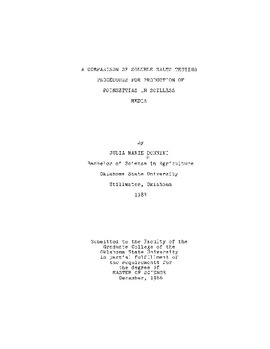| dc.contributor.advisor | Payne, Richard N. | |
| dc.contributor.author | Donnini, Julia Marie | |
| dc.date.accessioned | 2015-08-20T16:07:26Z | |
| dc.date.available | 2015-08-20T16:07:26Z | |
| dc.date.issued | 1986-12-01 | |
| dc.identifier.uri | https://hdl.handle.net/11244/15809 | |
| dc.description.abstract | Soluble salt measurements (millimhos/cm) using saturated paste extract, 1:2 dilution (volume), and leachate methods were compared to determine their relative efficiency and the reliability of existing interpretations. An attempt was also made to define guidelines for interpreting readings for the leachate method. Two soilless media and four levels of 20-4.4-16.6 N-P-K water soluble fertilizer at 100, 300, 500, and 700 ppm N were utilized for production of 'V-14 Glory' poinsettias (Euphorbia pulcherrima) and plants were fertilized at every watering. Three test dates at four week intervals were used. Reduced plant dry weight and height were observed as fertilizer rate in- 1 2 creased. Bract necrosis was noted on plants fertilized at 500 and 700 ppm. Tissue analysis indicated that N, P, and K concentrations increased with fertilizer level and Ca and Mg levels .were lower at higher fertilization levels. Solution analysis for nutrient content at the third testing date also indicated decreased Ca and Mg levels at higher fertilization levels while N, P, and K levels increased. pH became more acidic as fertilizer level increased but there was an overall slight increase in pH readings from date 1 to date 3. pH of the media corresponded closely to the pH of the solutions used for the 1:2 and saturated paste methods, but the pH for the leachate method solution was more acidic than for normal medium pH readings. Solubridge measurements from the leachate test demonstrated the most variability while the 1:2 test showed the least variability. The following guidelines were derived for each method: Saturated Paste: Safe- below 4.1 millimhos/cm. High possible growth inhibition, bract necrosis - 4.1 - 6.0. Excessive - plants may be severely injured - Above 6.0. 1:2 Dilution: Safe - below 1.5 mil1imhos/cm. High - possible growth inhibition, bract necrosis - 1.5 - 1.8. Excessive - plants may be severely injured - Above 1.8. Leachate Method: Safe -,below 5.7 High possible growth inhibition, bract necrosis - 5.7 - 7.2. Excessive- plants may be severely injured - Above 7.2. | |
| dc.format | application/pdf | |
| dc.language | en_US | |
| dc.publisher | Oklahoma State University | |
| dc.rights | Copyright is held by the author who has granted the Oklahoma State University Library the non-exclusive right to share this material in its institutional repository. Contact Digital Library Services at lib-dls@okstate.edu or 405-744-9161 for the permission policy on the use, reproduction or distribution of this material. | |
| dc.title | Comparison of Soluble Salts Testing Procedures for Production of Poinsettias in Soilless Media | |
| dc.type | text | |
| dc.contributor.committeeMember | Smith, Michael Wayne | |
| dc.contributor.committeeMember | McNew, Ronald W. | |
| osu.filename | Thesis-1986-D686c.pdf | |
| osu.accesstype | Open Access | |
| dc.description.department | Horticulture | |
| dc.type.genre | Thesis | |
